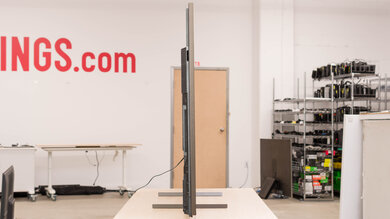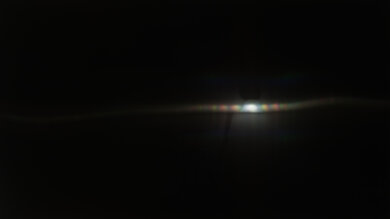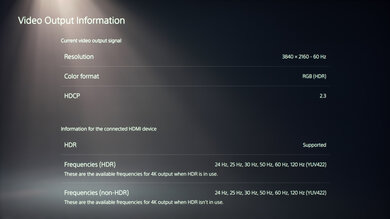The Sony X95J is a 4k TV with an LED backlight and full-array local dimming feature. Released as part of Sony's 2021 BRAVIA XR lineup, it's Sony's flagship 4k LED model and replaces the Sony X950H. It delivers an impressive experience, with excellent peak brightness in HDR, an amazing local dimming feature, and amazing gradient handling. Like many flagship LED-backlit models from different brands, it has an additional filter layer that improves viewing angles, but this comes at the expense of contrast, which is a bit low for a VA TV. Like the Sony X90J, it can't quite display a wide color gamut, but we don't expect most people to notice this. It also supports variable refresh rate technology, for a nearly tear-free gaming experience.
Our Verdict
The Sony X95J is a great TV for most uses. It's a great TV for watching movies in both SDR and HDR, as it's bright and has good contrast. It's bright enough to overcome glare, and it has surprisingly fair viewing angles, making it a very good choice for watching sports. Gamers will appreciate its low input lag, great response time, HDMI 2.1 support, and has variable refresh rate (VRR) support, but it doesn't support FreeSync.
- Bright enough to overcome glare.
- Huge selection of streaming apps.
- Upscales lower resolution content well.
- Some uniformity issues in dark scenes.
The Sony X95J is a great TV for watching movies in a dark room. It has a good contrast ratio, and the amazing local dimming feature helps to improve dark room performance. It upscales lower resolution content well and has a huge selection of apps if you like to stream movies. It can remove judder from any source, but there's some noticeable stutter when watching movies.
- Amazing local dimming feature.
- Can remove judder from any source.
- Upscales lower resolution content well.
- Some noticeable stutter in low frame rate content.
- Some uniformity issues in dark scenes.
The Sony X95J is an impressive TV for watching TV shows during the day. It has excellent reflection handling and gets bright enough to easily overcome glare in a bright room. There's a huge selection of streaming apps, so you're sure to find your favorite shows, and it upscales older content well. Although it has surprisingly fair viewing angles, it's not the best choice if you like to move around the house with the TV on.
- Bright enough to overcome glare.
- Huge selection of streaming apps.
- Upscales lower resolution content well.
- Image degrades at a moderate angle.
The Sony X95J is a very good TV for watching sports in a bright room. It gets plenty bright enough to overcome glare, and it has excellent reflection handling. It has a great response time, so you can see what's going and not just a blurry mess in fast-paced sports. Although the viewing angle is fair, it's not the best choice for a wide seating area. Unfortunately, it has just decent gray uniformity, and there are some uniformity issues on our unit.
- Bright enough to overcome glare.
- Upscales lower resolution content well.
- Great response time.
- Image degrades at a moderate angle.
The Sony X95J is an excellent TV for playing video games. It has a great response time, with very little blur behind fast-moving objects, and it has outstanding low input lag. It's also future-proof, with two HDMI 2.1 inputs for next-gen consoles or a PC. It supports VRR technology to reduce screen tearing once you update it to the latest firmware, but it doesn't support FreeSync.
- Amazing local dimming feature.
- Outstanding low input lag.
- Bright enough to overcome glare.
- HDMI 2.1 support.
- Great response time.
- HDMI Forum VRR support and G-SYNC compatibility.
- No FreeSync support.
- Some uniformity issues in dark scenes.
The Sony X95J is a very good TV for watching HDR movies in a dark room. It has good contrast and an amazing local dimming feature. It has excellent peak brightness in HDR, so bright highlights stand out. Unfortunately, there are some uniformity issues in dark scenes, and it can't display a wide color gamut, but this likely isn't very noticeable for most people.
- Amazing local dimming feature.
- Can remove judder from any source.
- Excellent peak brightness in HDR.
- HDMI Forum VRR support and G-SYNC compatibility.
- Some noticeable stutter in low frame rate content.
- Can't quite display a wide color gamut.
- Some uniformity issues in dark scenes.
The Sony X95J delivers an excellent gaming experience in HDR. It has a great response time, resulting in clear motion. It has low input lag for a responsive gaming experience. It has excellent peak brightness in HDR, so bright highlights stand out. Although it has good contrast, it has just okay black uniformity, and there are some noticeable uniformity issues in dark scenes. It supports VRR technology, which helps reduce screen tearing when gaming.
- Amazing local dimming feature.
- Outstanding low input lag.
- HDMI 2.1 support.
- Excellent peak brightness in HDR.
- Great response time.
- No FreeSync support.
- Can't quite display a wide color gamut.
- Some uniformity issues in dark scenes.
The Sony X95J is a great TV for use as a PC monitor. It has excellent reflection handling and amazing peak brightness, so it can easily overcome glare in a bright room. It supports most common resolutions and can display chroma 4:4:4 properly in most of them, which is important for clear text. Unfortunately, although it has fair viewing angles, the edges of the screen might appear non-uniform if you're sitting too close.
- Outstanding low input lag.
- Bright enough to overcome glare.
- HDMI 2.1 support.
- Great response time.
- Some uniformity issues in dark scenes.
Changelog
- Updated Oct 12, 2023: We uploaded the latest brightness measurements and uniformity photos for the Accelerated Longevity Test.
- Updated Jul 09, 2023: Sadly, while trying to diagnose the uniformity issues this TV has developed, the LCD panel broke. We've added a note to the Accelerated Longevity Test section of the review with more details.
- Updated Jun 07, 2023: We uploaded the latest brightness measurements and uniformity photos for the Accelerated Longevity Test.
- Updated Apr 03, 2023: We uploaded the brightness measurements and uniformity photos after running the TV for four months in our Accelerated Longevity Test.
Check Price
Differences Between Sizes And Variants
We tested the 75 inch Sony X95J Bravia XR TV (XB75X95J), and it's also available in a 65 inch and 85 inch size. We expect most of our results to be valid for the other sizes, but there are some slight differences in the 65 inch model.
| Size | US Model | Reflective Layer | Stand Positions |
|---|---|---|---|
| 65" | XR-65X95J | N/A | Standard & Soundbar |
| 75" | XR-75X95J | X-Anti Reflection layer | Standard, Narrow, & Soundbar |
| 85" | XR-85X95J | X-Anti Reflection layer | Standard, Narrow, & Soundbar |
If you come across a different type of panel or your Sony X95J doesn't correspond to our review, let us know, and we'll update the review. Note that some tests, like the gray uniformity, may vary between individual units.
Our unit was manufactured in July 2021; you can see the label here.
Popular TV Comparisons
The Sony X95J is a great TV with an amazing local dimming feature. It delivers an impressive experience, but there are a few oddities that stand out as potential deal-breakers for some buyers.
For more options, check out our recommendations for the best TVs, the best 4k gaming TVs, and the best movie TVs.
The Sony X95J is slightly better than the Sony X90J. The X95J has much better reflection handling, better viewing angles, and a better local dimming feature. The X95J is also much brighter, and small highlights stand out better in HDR. The X90J, on the other hand, has better native contrast and better black uniformity, with less cloudiness in dark scenes.
The Samsung QN90A is better than the Sony X95J, but if you really care about an accurate movie experience, some people might prefer the Sony. The Samsung has much better black uniformity and better contrast, but the Sony has a better local dimming feature, despite the Mini LED backlight on the Samsung. On the other hand, some people might prefer the Sony for watching HDR movies, as it tracks the EOTF more accurately, and many people prefer the processing on Sony TVs.
The Sony X95J is a bit of a downgrade from the Sony X950H in some ways. The X95J has a much better local dimming feature, but the X950H has better black uniformity and better contrast. The X95J is a bit better for gaming, though, with two HDMI 2.1 ports and VRR support.
The Sony X95J is higher-end than the Sony X90K/X90CK, meaning it provides better picture quality. If you want the best picture quality, especially for a wide seating arrangement, the X95J is the better choice because it has a wider viewing angle and better local dimming. However, if you want to spend a bit less, the X90K is also a great choice for dark room viewing because it has a better native contrast ratio, so blacks look deeper.

We buy and test dozens of TVs yearly, taking an objective, data-driven approach to deliver results you can trust. Our testing process is complex, with hundreds of individual tests that take over a week to complete. Most of our tests are done with specially designed test patterns that mimic real content, but we also use the same sources you have at home to ensure our results match the real-world experience. We use two main tools for our testing: a Colorimetry Research CR-100 colorimeter and a CR-250 spectroradiometer.
Test Results

The Sony X95J has a very nice design, with a flat metal border that goes around the screen, delivering a more premium feel than the Sony X90J. It has a very clean look, with panels that cover the inputs on the back, but there's no real cable management.
Unfortunately, a few weeks into our longevity test, this TV developed a serious uniformity issue. The left side of the screen is noticeably brighter and discolored compared to the right side of the screen.
We dismantled our unit to find the source of the uniformity issues. After inspecting the main board, electronics, and LEDs, we determined that the issue was likely in the LCD panel itself and not a backlight failure, as we initially suspected. Sadly, while trying to dismantle the LCD stack, it broke, and we're unable to repair it. This TV has now been removed from the longevity test, as we can't repair it and add it back to the test.
The feet are very small but support the TV well, with just a bit of wobble. You can attach the feet in three different positions on the 75 inch and 85 inch models. The photo shown here is in the narrow position, but there's also a wide position that offers better support (but requires a larger table), and a soundbar position that leaves enough room to place a soundbar in front of the TV without blocking the picture. Note that the narrow position shown here isn't available on the 65 inch model.
The footprint of the 75 inch model we bought varies depending on the position the feet are installed in. The height listed here is from the top surface of the table to the bottom of the screen and represents the tallest soundbar you can place in front without blocking the screen.
| Position | Width | Depth | Height |
| Narrow | 24.1" | 15.4" | 1.7" |
| Wide | 65.5" | 15.4" | 1.3" |
| Soundbar | 65.5" | 15.4" | 3.6" |
The back of the TV has a nice textured panel that looks great. There are plastic covers that hide the inputs and attachment points for the feet, but no real cable management.
The Sony X95J has good contrast. Native contrast with local dimming disabled is lower than usual for a VA panel, likely due to the X-Wide Angle filter, but this can also vary between individual units. The local dimming feature is extremely effective at boosting contrast but struggles with the checkerboard pattern used. With a half white/half black screen, we measured a contrast ratio with local dimming of 8916:1. With alternating full white/full black screens, we measured a contrast ratio of 22489:1 with local dimming enabled. Although the posted measurements are good, in practice with real content, this TV looks much better than these numbers suggest.
The Sony X95J has amazing peak brightness in SDR. It's bright enough to overcome glare in almost any room. Unfortunately, there's quite a bit of variation in peak brightness between different scenes, but this shouldn't be very noticeable with regular content.
We measured the SDR brightness after calibration in the 'Custom' Picture Mode, with Brightness at max, Contrast at '90', Color Tone set to 'Expert 1', Auto Local Dimming set to 'High', and Peak Luminance set to 'High'.
If you want a brighter image and don't mind losing image accuracy, set the Picture Mode to 'Vivid', Contrast to max, and Color Temperature to 'Cool'. We reached 1095 cd/m² in the 25% window with these settings.
We also tested the SDR brightness with Peak Luminance disabled. Turning it off makes the real scene brightness drop to 442 cd/m². It's more consistent, with most windows measuring between 470 cd/m² and 536 cd/m², but there's some frame dimming in the 2% windows, with both peak and sustained measuring around 410 cd/m².
The Sony X95J has excellent peak brightness in HDR. Small specular highlights in some scenes really stand out, and it's bright enough to deliver an impactful HDR experience, close to the content creator's intent in most scenes. If you want a TV with even higher peak brightness, then look into its replacement, the Sony X95K.
We measured the HDR brightness in the 'Custom' Picture Mode with Brightness at max, Contrast at '90', Color Tone set to 'Expert 2', HDR Tone Mapping set to 'Gradation Preferred', and Auto Local Dimming and Peak Luminance set to 'High'.
With Peak Luminance disabled, the brightness drops considerably, with all windows measuring between 562 cd/m² and 649 cd/m², except the 2% peak and sustained windows, which are around 497 cd/m² and 491 cd/m², respectively.
There's a slight decrease in peak brightness in HDR with Game Mode enabled. With test slides, Game Mode appears to be slightly less bright, so it's not just a margin of error difference, but it's not a significant difference.
It tracks the EOTF perfectly, so content is displayed at the correct brightness level. As the TV approaches its peak brightness, there's a sharp cutoff and actually a slight dip in peak brightness, so there can be a small loss of fine details in really bright scenes. Near-black scenes are displayed properly, with no noticeable black crush.
The Sony X95J has amazing gradient handling. There's some banding in darker shades of gray and green, but it's not very noticeable. There's a smooth gradation feature that can significantly reduce banding on the 'Medium' or 'High' setting; we don't recommend leaving it enabled, as it causes a loss of fine details.
The Sony X95J has decent overall gray uniformity, but this can vary between individual units. The sides of the screen are a bit darker than the center, and there's some noticeable dirty screen effect, which can be distracting when watching sports or browsing the web. In near-dark scenes, the uniformity is much better, with no noticeable issues.
Unfortunately, the Sony X95J has just okay black uniformity. The screen is a bit cloudy with local dimming disabled, which is disappointing from a VA panel, but this can vary between units. Enabling local dimming removes all of the cloudiness, but there's still a bit of blooming around the test cross due to the relatively large size of the dimming zones.
The Sony X95J has surprisingly fair viewing angles for a TV with a VA panel, thanks to Sony's X-Wide Viewing Angle layer. At moderate angles, the screen looks washed out a bit, as brightness fades and colors wash out, but most people shouldn't have any issues with it.
The Sony X95J we bought has excellent reflection handling. The anti-reflective coating on the 75 inch model disperses bright lights across the screen, significantly reducing their intensity but creating a rainbow pattern that can be distracting in some cases. The 85 inch model has the same reflective coating, so we expect it to perform about the same, but the 65 inch model doesn't, so we expect it to have worse reflection handling.
Before calibration, the Sony X95J we bought has impressive accuracy. Gamma follows our target almost perfectly, and the color temperature is very close to our target. The white balance is great overall, but some brighter scenes are a bit off. Colors are excellent, but all colors are undersaturated a bit. This can vary between units, but Sony TVs are generally pretty accurate out of the box.
After calibration, the Sony X95J has nearly perfect accuracy. Any remaining issues with the white balance aren't noticeable without a colorimeter, gamma is still almost perfect, and the color temperature is nearly perfect. We couldn't improve color accuracy very much, but most colors aren't undersaturated anymore and any remaining issues aren't noticeable.
You can see our recommended settings here.
The Sony X95J uses a BGR subpixel layout. It doesn't affect picture quality, but it can cause blurry text in some applications when using it as a PC monitor. You can read more about it here.
The Sony X95J has a good color gamut, but like the Sony X90J, it can't quite display a wide color gamut. We're not sure why these two TVs behave this way, but in a side-by-side comparison with a TV with a wider color gamut, the difference is noticeable with test slides. In real content the different isn't that noticeable, though. We also did a check with a 50% stimulus instead of our usual 75% slide:
- DCI P3 xy: 87.87%
- DCI P3 uv: 92.91%
- DCI P3 Color Gamut
- Rec. 2020 xy: 64.27%
- Rec. 2020 uv: 69.94%
- Rec. 2020 Color Gamut
With a 50% stimulus the X95J can display a wide color gamut, but the difference isn't significant. For consistency with our other TV reviews, the official results are with the 75% stimulus. Even though it falls short of what we consider to be a wide color gamut, unless you're comparing two displays side-by-side, most people won't notice the difference.
The Sony X95J has decent color volume. It's limited by the incomplete color gamut, as it can't display the full range of colors in either DCI P3 or Rec. 2020.
The Sony X95J has a great response time. Like most VA panels on the market, it's significantly slower to transition out of dark scenes, so some black smearing is noticeable in certain content. There's very little blur behind fast-moving objects in most scenes.
The Sony X95J has an optional backlight strobing feature that can improve the appearance of motion at the expense of peak brightness. Unfortunately, it can only flicker at 120Hz, even when playing 60Hz content, which can cause noticeable duplications in motion. Our scoring is based only on the flicker frequencies supported and doesn't indicate how well the backlight strobing feature works.
Update 09/09/2021: There was a mistake in the motion interpolation results. This TV can interpolate from 60 to 120 FPS.
The Sony X95J has an optional motion interpolation feature to improve the appearance of motion. It works well in slower scenes, but there are significant artifacts around fast-moving objects. Like the Sony X90J, we noticed glitches and issues in some content.
Due to the relatively fast response time of the Sony X95J, there's some stutter when watching low frame rate content like movies. This is especially noticeable in slow panning shots.
The Sony X95J can remove judder from all sources. For native 24p sources, like a Blu-ray player or some external video players, no additional settings are required. For sources that can only send a 60p/60i signal and for the native apps, additional settings are required.
The Sony X95J has a variable refresh rate feature to reduce screen tearing when gaming. The VRR feature works across the TV's entire refresh rate range, and it supports Low Framerate Compensation (LFC), so even if your frame rate drops low, it'll remain nearly tear-free. It supports HDMI Forum VRR, meaning it can take full advantage of the Xbox Series X, PS5, or any recent NVIDIA graphics card, but it still doesn't work properly with AMD graphics cards.
Update 03/04/2022: Sony released an update to include VRR support with firmware PKG6.5660.0668NAA. However, we couldn't get proper VRR input lag readings because the TV kept crashing. We experienced the same issue with other TVs like the Sony X90J, and we're looking into it.
The Sony X95J has outstanding low input lag, as long as you're in the 'Game' Picture Mode. Outside of Game Mode, or with motion interpolation enabled, the input lag is too high for most gamers.
The Sony X95J supports most common resolutions natively. 1440p requires a forced resolution for 60Hz, but even then, it can't display chroma 4:4:4 properly, so text looks blurry from a PC. It displays 4:4:4 properly in all of the other formats we tested, which is important for clear text.
Some recent Sony TVs, including the Sony X85J, haven't been able to display a 4k @ 120Hz signal with proper chroma 4:4:4, even from an HDMI 2.1 source. We tried to reproduce the issue on the X95J, but as far as we can tell, there's no blur when displaying 4k @ 120Hz on this TV. We tested this from an RTX 3080 and double-checked with a PS5 and Xbox Series X, both on the home screen and in a few games that support 4k @ 120Hz, and there isn't any problem.
Update 03/04/2022: The Sony X95J now supports both VRR and ALLM with the Xbox Series X after a firmware update (PKG6.5660.0668NAA).
The Sony X95J supports most features of the PS5 and Xbox Series X. It doesn't support 4k @ 120Hz with Dolby Vision, so you have to decide between 4k @ 120Hz or 4k @ 60Hz in Dolby Vision. The supported formats from an Xbox vary depending on the HDMI Signal Format selected. Setting it to 'Enhanced Format (Dolby Vision)' limits the supported features, and blocks the TV from accepting a 4k @ 120Hz signal.
The Sony X95J has two HDMI 2.1 ports, but one of them is also the eARC port, so if you're planning on connecting a receiver or soundbar over eARC, you'll only be able to take full advantage of one next-gen console.
Update 09/20/2021: We retested the audio passthrough over eARC. DTS-X is working properly, but the Sound mode sync setting has to be enabled for it to work.
The Sony X95J supports all of the high-end audio formats, and can supports passthrough to supported audio receivers or soundbars through ARC or eARC.
The Sony X95J has a decent frequency response. Like most TVs, it lacks thump or rumble in its bass response. The frequency response is balanced above the low-frequency extension, resulting in clear dialogue. It can get very loud, which is good for large or noisy environments, although there's some compression when playing at max volume. There's a digital room correction feature that tunes the frequency response to best suit your rooms' acoustics.
The Sony X95J has decent distortion performance. The amount of total harmonic distortion is low at moderate volume levels but increases significantly near max volume. Note that the amount of distortion present varies depending on the content, and some people may not hear it.
Note: Our distortion measurements show that there's less intermodular distortion at max volume. This is unexpected and doesn't match what we hear from the TV. We checked these results three times, and they were consistent. We're not sure why this is, but it's most likely an issue with our testing or room setup. We're looking into it, and we'll update the review if we can identify the issue.
Like other 2021 Sony TVs, the Sony X95J runs on Google TV, which is mainly a cosmetic upgrade over the previous Android TV interface. It's fairly easy to use and runs very smoothly. We didn't notice any issues or bugs with the interface during testing.
The built-in Google Play Store has a massive selection of apps, so you're sure to find your favorite streaming service. It also has built-in Chromecast and Apple AirPlay support, so you can cast from pretty much any mobile device.
The included remote is sleek and easy to use. There are quick-access buttons for a few streaming services and a built-in mic for voice control. The TV also has its own built-in mic. Voice control can be used to change inputs, open apps, search for basic information online, and even change some of the TV's settings.



























































